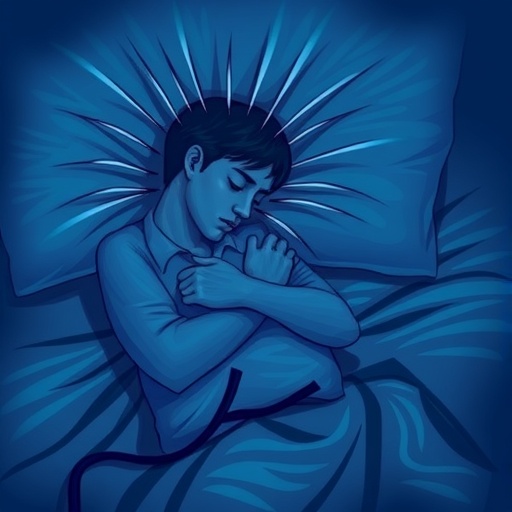Sleep disturbances have long been intertwined with mental health challenges, but recent advancements reveal deeper complexities, especially among adolescents grappling with depression. A pioneering study published in BMC Psychiatry uncovers a compelling link between sleep patterns and non-suicidal self-injury (NSSI) behaviors in depressed youths. This groundbreaking research not only sheds light on the biology of self-harm tendencies but also points toward novel avenues for early identification and intervention.
Conducted as a rigorous case-control study, the investigation involved 125 adolescents aged between 12 and 19 years, hospitalized during the critical period from December 2022 to June 2024. The participants were meticulously categorized into two groups: those exhibiting NSSI behaviors (n=70) and their counterparts without such behaviors (n=55). This stratification allowed researchers to delve into possible variances in sleep characteristics that might correlate with self-injury tendencies in the context of depressive episodes.
Central to this study was the dual approach for assessing sleep: subjective evaluations using the Pittsburgh Sleep Quality Index (PSQI) and objective measurements via polysomnography, a sophisticated technique that monitors brain waves, oxygen levels, heart rate, and eye and leg movements during sleep. By employing both methods, researchers obtained a nuanced picture of sleep quality and architecture, ranging from how adolescents perceive their rest to the concrete physiological metrics captured overnight.
The findings revealed distinct discrepancies in sleep patterns between adolescents with and without NSSI. Beyond mere anecdotal accounts, objective data uncovered significantly increased sleep latency in self-harming youths, indicating prolonged time to fall asleep. This prolonged delay was statistically significant, with an odds ratio (OR) suggesting a subtle but definitive relationship between the length of sleep onset and the propensity for NSSI behaviors. Such evidence points to possible neurophysiological disruptions or heightened arousal states that interfere with the transition to restful sleep.
Subjectively, adolescents engaging in NSSI also reported experiencing sleep insufficiency to a greater extent. Statistical analysis confirmed these self-reports, illustrating a tangible link between perceived inadequate rest and self-injurious actions. This concordance between objective and subjective data fortifies the argument that sleep disturbances are not just co-occurring phenomena but might play a contributory role in the development or persistence of NSSI in depressed adolescents.
Moreover, the study identified noteworthy demographic and clinical differences between the groups. Gender distribution varied significantly, alongside differences in the severity of depressive symptoms, anxiety levels, and overall psychological profiles. These findings underscore the multifaceted nature of self-harm behaviors and the importance of considering an interplay of biological, psychological, and social factors when addressing adolescent mental health.
Given these observations, sleep emerges as a promising focal point for non-invasive biomarkers in assessing the risk of non-suicidal self-injury. The combination of reduced total sleep duration and delayed sleep onset could serve clinicians as early warning signals, prompting proactive therapeutic strategies tailored to improve sleep hygiene and address underlying mood disturbances. Intervening at this juncture might reduce not only self-harm incidences but also the broader burden of adolescent depression.
This research invites a paradigm shift in adolescent psychiatry, emphasizing the critical role of sleep in emotional regulation and behavioral outcomes. The polysomnographic insights enrich our understanding of how neurobiological mechanisms, reflected in measurable sleep parameters, correspond with complex behaviors like NSSI. This approach bridges the gap between subjective symptom reports and tangible biological markers.
In addition, the study propels the conversation forward about preventative mental health care. By harnessing sleep data, clinicians can move beyond symptomatic treatment to a more predictive and personalized model. Such precision medicine aligns with current initiatives aiming to mitigate suicide risk and self-harm behaviors through early detection and intervention.
Furthermore, the interrelationship between anxiety, depression severity, and sleep disturbances observed in the study prompts holistic assessments in clinical settings. Addressing sleep irregularities may yield secondary benefits, easing anxiety and depressive symptoms, thereby creating a virtuous cycle of improved mental health outcomes for vulnerable adolescents.
However, the study authors caution that while the connections are significant, causality remains to be fully elucidated. Future longitudinal studies are warranted to unpack whether disrupted sleep directly precipitates NSSI behaviors or if self-injury itself alters sleep architecture. Nonetheless, these findings mark a critical advancement in our comprehension of adolescent psychopathology.
In sum, this landmark investigation opens promising pathways for research and clinical practice. By valuing sleep as a vital sign of psychological well-being, mental health practitioners can devise more effective strategies to combat the growing epidemic of non-suicidal self-injury among depressed youths. This multifaceted approach leverages robust technology alongside clinical observations to navigate the intricate landscape of adolescent mental health care.
Sleep, an often-overlooked pillar of health, now stands in the spotlight as a key element linked to the expression of self-harming behaviors in depressed adolescents. The synergy between subjective experiences and objective polysomnographic findings offers a beacon of hope for early diagnosis and intervention, potentially saving young lives through timely, targeted support.
Subject of Research: Sleep characteristics and their association with non-suicidal self-injury among adolescents experiencing depressive episodes.
Article Title: Sleep characteristics and non-suicidal self-injury: unveiling the association in depressed adolescents
Article References:
Liang, J., Liu, Y., Zhang, T. et al. Sleep characteristics and non-suicidal self-injury: unveiling the association in depressed adolescents. BMC Psychiatry 25, 1027 (2025). https://doi.org/10.1186/s12888-025-07466-z
Image Credits: AI Generated
DOI: https://doi.org/10.1186/s12888-025-07466-z




